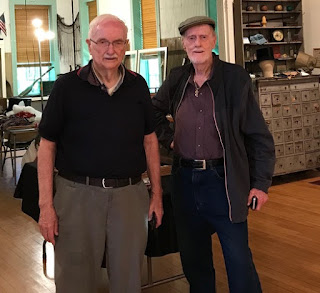Writing this article literally made me hungry for bread and donuts. Reader beware!
Wheat has long been a part of the Bethlehem story. In the
very early days of what was to become our town, in the fall of 1631to be exact,
Brant Peelen planted 24 acres of wheat on an island in the Hudson River at the
mouth of a creek. The island is now known as Westerlo Island and the creek is
the Normans Kill. Peelen had come to New Netherland the previous year along
with his wife Lubbertje Wouters, their children Lysebeth, Geert and Gerritje,
and other settlers. They were part of Killiaen Van Rensselaer’s grand plan to
exploit the resources of his new territory. In the years to come, the Van
Rensselaer Manor grew to cover thousands of acres on both sides of the Hudson,
including Bethlehem.
The Van Rensselaer’s developed a decidedly feudal system whereby
settlers could secure land in exchange for annual rents. Landlords like the Patroon Stephen Van
Rensselaer preferred payment in wheat. Besides tenant farmers simply not having
any cash money, the value of money could fluctuate wildly.
The collection of the Bethlehem Historical Association has a
receipt book kept by Adam Winne from 1769 until 1830 recording his rent payments
made to the Patroon. His 300+ acres were located along the Hudson north of the
Vlomankill. The very first entry in the journal is written in Dutch and dates
to 1769. Another early one records his payment of “thirty five shipel” of wheat,
ten fowls, and one day driving. He also paid ten pounds for rent on a grist
mill. It is dated February 12, 1776. A shipel, or schepel in modern Dutch, was
equivalent to a bushel.
 |
Members of the Degenaar family harvesting cucumbers in 1921.
Notice the bushel baskets.
Their farm was located on River Road in Cedar Hill. |
During this time, wheat was one of several cash crops for Albany
area farmers. Others included peas and hay. Lumber was also an important part
of the economy. A 1790 ad in the
Albany
Register hints at the economics of the time. W. M. McGill, at the North
Gate, Albany, stated that he had “just received a neat assortment of dry goods…
which he will sell on low terms, for cash or country produce.” He also has on
hand “a supply of liquors and groceries… West India rum, brandy, gin…also sugar
and tea…cod fish and cider.” The ad ends with this “Cash paid for staves, wheat
and peas.” Country produce is just what Bethlehem farmers could barter, and
they could receive needed cash for staves (wooden posts or planks), wheat and
peas.
 |
The McGill ad from the February 22, 1790 issue of the Albany Register. Notice the letter f is used for the s sound
in the middle of words. For example,
“Suitable for the prefent and approaching Seafon.” |
What happened to all that wheat? Much of it was sent to
market in Albany or floated down the Hudson River to New York City. Bethlehem
farmers were nicely situated to take advantage of these markets. Bethlehem also
had access to the Normanskill and Vlomankill where water powered grist mills to
grind the wheat into flour. And what is the best result of all that flour?
Bread of course.
Baking on a commercial scale was common early on. A list of
inhabitants of the City of Albany compiled by the British army in 1756 for the
purpose of quartering troops starts with Saunders Lawnson, baker. Of 329
residences visited within the stockade, seven included bakers. Bakers only
slightly out number brewers (wheat is essential for ale and beer.) In 1798,
Albany Mayor Abraham Ten Broeck published the Assize of Bread (an ancient
method of setting the price for bread) as “a loaf of good common or tail wheat
flour, to weigh one ounce eight ounces for 6 d.” 6d would be six pence in the
British system.
 |
Mayor Ten Broeck’s announcement of the Assize of Wheat is
found in the April 27, 1798 issue of the Albany
Register. The ad above it urges one to
contact Obadiah Cooper about renting a new dwelling house and the one to the
right is a runaway slave notice. |
Over the years Bethlehem has had an assortment of bakeries
often featuring home delivery of bread, cakes and pies. One was Dempf’s Bakery
on Delaware Avenue. Louis Dempf operated his shop from 1927 until 1954. Down
the street at the Four Corners was the Delmar Bakery in operation from the
1930s until the 1960s. A discussion of bakeries would not be complete without
mention of Freihofer’s whose home delivery service was extensive in our area. A
1961 ad in the
Spotlight highlights
batter-whipped Sunbeam bread and a whole host of other items including butter
parker house rolls, strawberry rhubarb pie and jelly donuts. The ad ends with a
reminder to watch Freddie Freihofer on WRGB on weekday afternoons. I’ll leave
it to you the reader to go to YouTube to enjoy some Freddie Freihofer videos.
 |
Louis Dempf operated his bakery on Delaware Avenue from 1927
to 1954. The house on the left still stands on Delaware just before the
underpass. The bakery building and house on the right are long gone. |
 |
| In an ad from the
1940s, Loni Dempf leans out of the Dempf Pastry Shop delivery van. |
*****************
Pop over to
http://www.ourtownebethlehem.com/ for the latest issue.
Hop over here for Adam Winne's account book (put Adam Winne in the search bar.)
https://nyheritage.org/#explore
Skip over here to browse that 1756 census
http://exhibitions.nysm.nysed.gov//albany/census1756.html
Jump to YouTube for Freddie!
https://www.youtube.com/watch?v=5C4CocX5MGM








